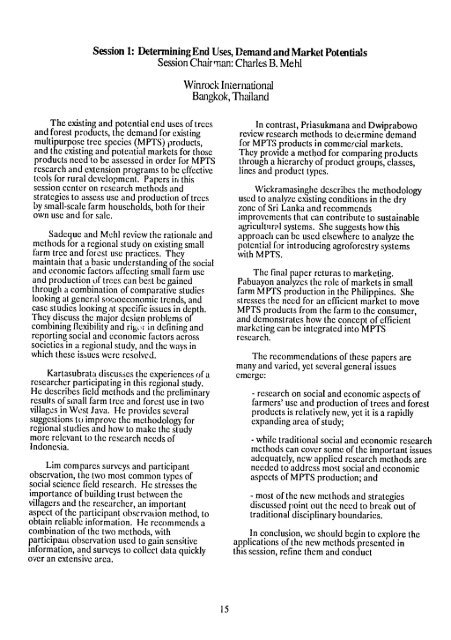multipurpose tree species research for small farms: strategies ... - part
multipurpose tree species research for small farms: strategies ... - part
multipurpose tree species research for small farms: strategies ... - part
Create successful ePaper yourself
Turn your PDF publications into a flip-book with our unique Google optimized e-Paper software.
Session 1: Determining End Uses, Demand and Market Potentials<br />
Session Chairman: Charles B.Mehl<br />
The existing and potential end uses of <strong>tree</strong>s<br />
and <strong>for</strong>est products, the demand <strong>for</strong> existing<br />
<strong>multipurpose</strong> <strong>tree</strong> <strong>species</strong> (MPTS) products,<br />
and the existing and potential markets <strong>for</strong> those<br />
products need to be assessed in order <strong>for</strong> MPTS<br />
<strong>research</strong> and extension programs to be effective<br />
tools <strong>for</strong> rural development. Papers inthis<br />
session center on <strong>research</strong> methods and<br />
<strong>strategies</strong> to assess use and production of <strong>tree</strong>s<br />
by <strong>small</strong>-scale farm households, both <strong>for</strong> their<br />
own use and <strong>for</strong> sale.<br />
Sadeque and Mehl review the rationale and<br />
methods <strong>for</strong> a regional study on existing <strong>small</strong><br />
farm <strong>tree</strong> and <strong>for</strong>est usexractices. They<br />
maintain that a basic understanding of the social<br />
and economic factors affecting <strong>small</strong> farm use<br />
and production of <strong>tree</strong>s can best be gained<br />
through a combination of comparative studies<br />
looking at generd socioeconomic trends, and<br />
case studies looking at specific issues in depth.<br />
They discuss the major design problems of<br />
combining flexibility and rigo, in defining and<br />
reporting social and economic factors across<br />
societies in a regional study, and the ways in<br />
which these issues were resolved.<br />
Kartasubrata discusses the experiences of a<br />
<strong>research</strong>er <strong>part</strong>icipating in this regional study.<br />
He describes field methods and the preliminary<br />
results of <strong>small</strong> farm <strong>tree</strong> and <strong>for</strong>est use in two<br />
villages in West Java. He provides several<br />
suggestions to improve the methodology <strong>for</strong><br />
regional studies and how to make the study<br />
more relevant to the <strong>research</strong> needs of<br />
Indonesia.<br />
Lim compares surveys and <strong>part</strong>icipant<br />
observation, the two most common types of<br />
social science field <strong>research</strong>. He stresses the<br />
importance of building trust between the<br />
villagers and the <strong>research</strong>er, an important<br />
aspect of the <strong>part</strong>icipant observation method, to<br />
obtain reliable in<strong>for</strong>mation. He recommends a<br />
combination of the two methods, with<br />
<strong>part</strong>icipant observation used to gain sensitive<br />
in<strong>for</strong>mation, and surveys to collect data quickly<br />
over an extensive area.<br />
Winrock International<br />
Bangkok, Thailand<br />
15<br />
In contrast, Priasukmana and Dwiprabowo<br />
review <strong>research</strong> methods to determine demand<br />
<strong>for</strong> MPTS products in commercial markets.<br />
They provide a method <strong>for</strong> comparing products<br />
through a hierarchy of product groups, classes,<br />
lines and product types.<br />
Wickramasinghe describes the methodology<br />
used to analyze existing conditions in the dry<br />
zone of Sri Lanka and recommends<br />
improvements that can contribute to sustainable<br />
agricultural systems. She suggests how this<br />
approach can be used elsewhere to analyze the<br />
potential <strong>for</strong> introducing agro<strong>for</strong>estry systems<br />
with MPTS.<br />
The final paper returns to marketing.<br />
Pabuayon analyzes the role of markets in <strong>small</strong><br />
farm MPTS production in the Philippines. She<br />
stresses the need <strong>for</strong> an efficient market to move<br />
MPTS products from the farm to the consumer,<br />
and demonstrates how the concept of efficient<br />
marketing can be integrated into MPTS<br />
<strong>research</strong>.<br />
The recommendations of these papers are<br />
many and varied, yet several general issues<br />
emerge:<br />
- <strong>research</strong> on social and economic aspects of<br />
farmers' use and production of <strong>tree</strong>s and <strong>for</strong>est<br />
products is relatively new, yet it is a rapidly<br />
expanding area of study;<br />
- while traditional social and economic <strong>research</strong><br />
methods can cover some of the important issues<br />
adequately, new applied <strong>research</strong> methods are<br />
neced to address most social and economic<br />
aspects of MPTS production; and<br />
- most of the new methods and <strong>strategies</strong><br />
discussed point out the need to break out of<br />
traditional disciplinary boundaries.<br />
In conclusion, we should begin to explore the<br />
applications of the new methods presented in<br />
this session, refine them and conduct

















